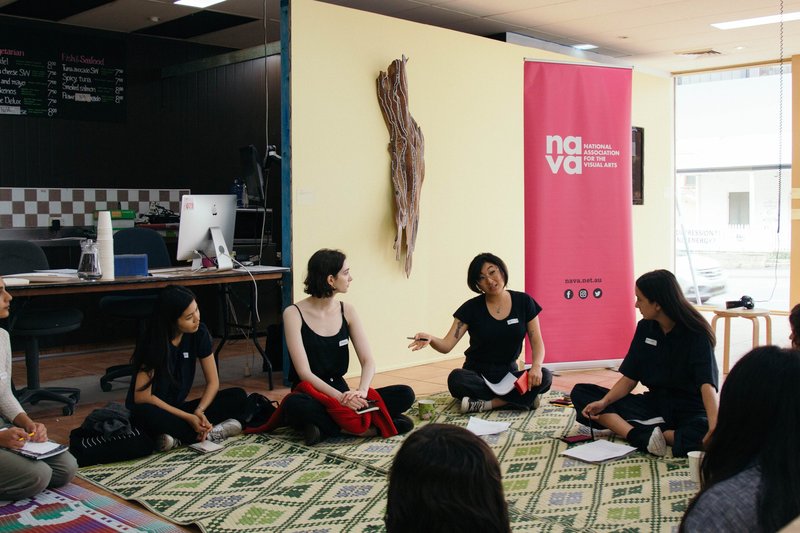Developing Arts Criticism Review
Reflecting on NAVA's recent conversation on developing visual arts criticism in Australia.
Photo by Gianna Hayes.
Reflecting on NAVA's recent conversation on developing visual arts criticism in Australia.
Photo by Gianna Hayes.

In 2016, Orit Gat wrote in her E-Flux essay that gallery-goers are reading in galleries as much as they are looking. What is the place of arts writing in a time where we might be reading more than we are looking? Or as Gat continues, could reading be synonymous with looking? At NAVA's recent event, Developing Art Criticism at Pari, Parramatta, arts writers and editors from Runway Journal, Vault Magazine, Running Dog, Peril Magazine shared insights and observations on what it means to write in 2019 and beyond, and the role of arts writing in the art world ecosystem. The varied nature of arts writing itself (from writing criticism, to catalogue essays, creative ekphrastic responses, gallery wall text), brought together writers from disparate disciplines and experiences who all played a part in the vital conversation.
Arts criticism in Australia today must confront a legacy of being deeply entrenched in the domain of the white, male art historian, having imported its model from the Euro-American colonial understanding of the conventional critic. Instead, organisations and publications that spearhead specific outreach programs like Sweatshop and Running Dog have been seminal in introducing new, emerging voices to the arts writing world. By doing so they recognise that arts writing is not always a solitary act, and attempt to move away from the preconception of the art critic as the lone authoritative voice. Rather, writers and editors are now searching for ways that writing may be communal and open. These publications recognise that the current call-out structure as it stands is a problem, especially when outreach is not a priority for publications. The sustained hierarchy means that editors almost always expect to receive pitches but not necessarily from different voices.
An effective way to find and support emerging voices is through mentorships, that provide the invaluable and rare opportunity to be given one-on-one feedback. Whilst a few mentorships such as the Performance Space and Runway Journal Mentorship, Kudos Emerging Critics Award, Gertrude Contemporary Emerging Writer’s Program, Firstdraft Writers Program, and ACCA’s Writing in the Expanded Field Program exist, writers and editors in Australia are looking for more support. In particular, editorial mentorships are incredibly scarce when editing is never a taught skill and editorial positions requires large amounts of personal and emotional investment. This invisible labour that goes into arts writing is often dismissed and remains unacknowledged. The writers who came together at PARI expressed a desire to sustainably and continually meet others in physical spaces. To meet is to hold space which in turn is to recognise the importance of the work done by writers and editors. Public programs allow individuals to develop the vital, nourishing relationships that occur between writers and between editors and writers. Often these public programs may devolve into spaces of complaint and cynicism, which are important and valid. However, perhaps, they must also be counter-balanced with forums that are purely based on connection, solidarity, and empowerment.
Indeed, when these early steps of arts writing are anxiety-ridden and obfuscated, to meet and gather galvanises shared passions. Online, this takes shape in Facebook Groups such as Young Australian Writers which provides valuable resources such as spreadsheets of editors to contact, pay rates and personal experiences shared between emerging and freelance writers.
Undoubtedly, and to no surprise, this precarity derives from the greatest challenge that arts writing faces, which is funding. Arts writers and organisations have to survive on a limited pool, relying on funding bodies from either literature or visual arts, but very rarely both. Unless they decide to introduce a pay-wall, which then compromises access for readers, publications are often left in unstable situations.
Nonetheless, there is a sense of resilience that emerges from these fiscal constraints. Whilst simultaneously understanding financial situations, the art writer is free to write outside of capital, to write critically and honestly, which is often compromised in more monopolised streams where galleries are interested in publicity and marketing. New forms of expansive writing have emerged, that firmly situates themselves outside of the mainstream. These new forms often embrace digital realms, inviting poems, fiction and other creative responses to visual arts. These new forms often encourage discipline, intellectual rigour and radical slowness when writers are increasingly programmed to write quickly and produce more output.
For editors, this may look like editorial care. Editors look to deeply challenge what a writer may have said, instead of simply editing for a writer or mindlessly publishing their words, in the hopes of simply publishing more for their journal/publication. For writers, this value may be measured by its capacity to foster empathy and growth (both individually and collectively). It is worth interrogating how much of our identities as writers have been constructed/constrained by capitalism, whilst also encouraging or looking at new ways to quantify value outside of capitalism when it comes to arts writing today.
This project is supported by the NSW Government through Create NSW.